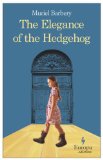Summary | Excerpt | Reading Guide | Reviews | Beyond the Book | Read-Alikes | Genres & Themes | Author Bio

This article relates to The Elegance of the Hedgehog
Author Muriel Barbery (who currently lives in Kyoto with her husband) reveals a
passion for the arts and cultural practices of Japan as she incorporates
references to Japanese poets, directors, films, and traditions into The
Elegance of the Hedgehog.
The term wabi-sabi, in its simplest form, is the Japanese view of a
simple aesthetic; less is more. Overall, it is a kind of quiet, mellow beauty
that is uncluttered and alleviates the weight of the material. Originally two
words, they have been paired over time to express harmony, grace, and simple
beauty. One who is wabi-sabi has an understated appreciation of nature's beauty
and finds peace in simplicity. Likewise, the term can be applied to styles of
art, architecture, or design.
Basho (ne Matsuo Munefusa) was born in 1644 outside of Kyoto,
Japan. Born into a prominent samurai family, Basho rejected his surroundings and
became a wanderer. Living on humble donations from his growing number of
students, he studied Zen and Chinese poetry, focusing on haiku and the
meditative way of the ancients. In his belief that poetry was a source of
enlightenment, he focused on simple images to inspire the profound, and
approached poetry as a way of life. Basho is considered one of the finest
writers of Japanese haiku - haiku being a form of lyric verse having three
unrhymed lines of five, seven and five syllables, traditionally invoking nature.
Read translations of Basho haiku (due to the challenges of translating
Japanese haiku into English, the translations don't always follow the 5-7-5
rule).
Yasujiro Ozu (1903-1963) was a Japanese filmmaker of great influence.
With his unique technical style, Ozu is considered to be "the most Japanese of
all directors." (Ozu:
His Life and Films, by Donald Richie). With his career spanning 35
years, he took the genre of gendai-geki (contemporary drama) from obscure, to a
level of high art. His films such as Tokyo Story and Sisters Munakata
portray his contemplative, minimalist style, while focusing on the struggles of
everyday life.
Shan Sa is a Beijing-born fiction writer who now lives in France. Born in
1972, she began writing at an early age, publishing as young as 8 years old. In
1990, she moved from China to France, where she studied philosophy, learned the
language, and worked with the painter Balthus. She is the author of several
novels including, The Four Lives of the Willow, Alexander and Alestria
and The Girl Who Played Go. In addition to her award winning novels, Shan
Sa is also a celebrated painter whose works have been exhibited in both Paris
and New York.
GO, known as Wei Qi in China and Baduk in Korea, is said to be the oldest
board game played in its original form. Go is a complex two player game which
focuses on capturing territory, far surpassing chess in both strategic skills
and scope. The idea is to conquer a larger part of the board than your
opponent. The placement of stones on the board (representing conquered
territory) can lead to countless numbers of intriguing patterns as territory is
acquired. Though intellectually rigorous, the game has fewer rules than most
board games. Go is as intricate as the stones and boards it is sometimes played
upon, which have been raised to great heights of aesthetic beauty by the
Japanese. From
simple to
ornate, Go boards and stones are an art form of their own. You can learn to
play go with
this interactive tutorial (your computer may prompt you to install a
Japanese language pack to view this website, it is not necessary to do so).
![]() This article relates to The Elegance of the Hedgehog.
It first ran in the February 5, 2009
issue of BookBrowse Recommends.
This article relates to The Elegance of the Hedgehog.
It first ran in the February 5, 2009
issue of BookBrowse Recommends.
Your guide toexceptional books
BookBrowse seeks out and recommends the best in contemporary fiction and nonfiction—books that not only engage and entertain but also deepen our understanding of ourselves and the world around us.